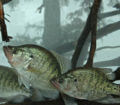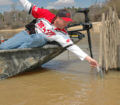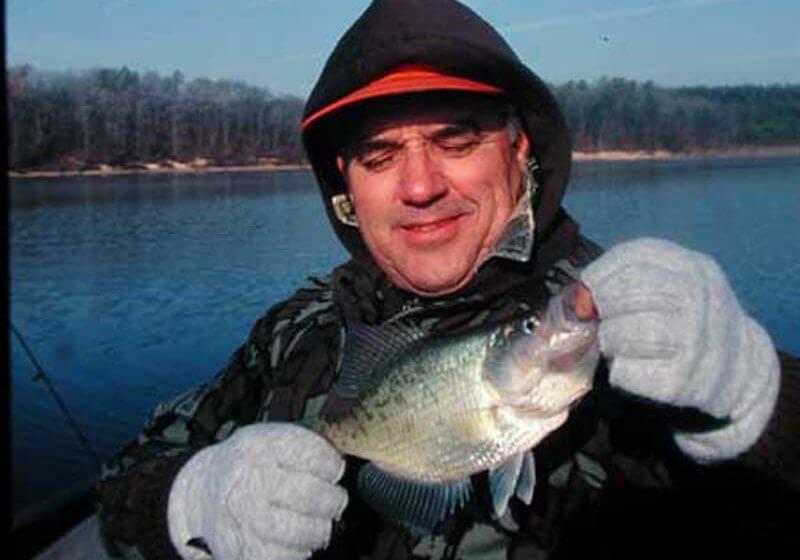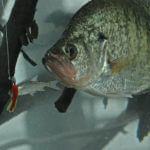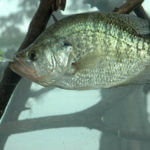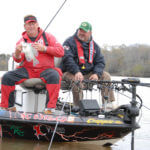Editors Note: Bob Jones from Piqua, Ohio, fishes the competitive crappie-fishing circuits and is as addicted to crappie fishing as a bird dog is to finding quail. Unlike most crappie fishermen who sit next to the fire during the winter months, Jones is out trying to find papermouths, even in bad weather. In Ohio, where Jones lives, the lakes often will freeze up. Sometimes, Jones has open water to fish.
 “When I go to the lake this week I will spider-web my poles,” Jones explains. “You can only fish two poles per person in Ohio, so if I have someone with me, I’ll put four poles in the water. I like 12-foot poles with sensitivity. I troll small, ice jigs with little spinner blades; also I like to tip the jigs with wax worms. When the weather gets cold, the crappie go to the deeper holes, and then they don’t want to eat very much. But I’ve found that many times a crappie will eat extremely-small jigs, grubs and worms like wax worms. My ice jigs are generally around 1/2-inch long and weigh from 1/32- to 1/64- of an ounce. To get my jig down, I put a 1/4-ounce weight on the bottom of the line and tie two ice jigs above the weight. I usually fish from 15-feet to 30-feet down. I fish 12- to 15-feet-deep ledges with 30- or 40-feet-deep drop-offs.
“When I go to the lake this week I will spider-web my poles,” Jones explains. “You can only fish two poles per person in Ohio, so if I have someone with me, I’ll put four poles in the water. I like 12-foot poles with sensitivity. I troll small, ice jigs with little spinner blades; also I like to tip the jigs with wax worms. When the weather gets cold, the crappie go to the deeper holes, and then they don’t want to eat very much. But I’ve found that many times a crappie will eat extremely-small jigs, grubs and worms like wax worms. My ice jigs are generally around 1/2-inch long and weigh from 1/32- to 1/64- of an ounce. To get my jig down, I put a 1/4-ounce weight on the bottom of the line and tie two ice jigs above the weight. I usually fish from 15-feet to 30-feet down. I fish 12- to 15-feet-deep ledges with 30- or 40-feet-deep drop-offs.
“I use my depth finder to locate crappie holding on structure and to see schools of crappie. I move my boat very slowly. If someone is watching me from the bank, he won’t even know the boat is moving. Once I get a bite, I stop the boat, anchor down and vertical jig. I fish with one pole instead of two, since the bite is so light you can hardly feel it. Many times you won’t be able to detect the bite if you’re slow trolling, so when I find a crappie that will bite my jig, I start fishing vertically.
 “When I’m slow trolling, I troll at less than 1 mph and use my hand-held GPS to keep up with the speed of my boat. In the spring, I troll from 1-1/2 to 3 mph, but at this time of year, I really want to go slow. I use 6-pound-test fluorocarbon line, which I have a lot of confidence in because it becomes invisible below the surface. When I look at the line on the end of my pole, I can hardly see it. Therefore, I don’t believe the crappie can see the line when it is underwater.
“When I’m slow trolling, I troll at less than 1 mph and use my hand-held GPS to keep up with the speed of my boat. In the spring, I troll from 1-1/2 to 3 mph, but at this time of year, I really want to go slow. I use 6-pound-test fluorocarbon line, which I have a lot of confidence in because it becomes invisible below the surface. When I look at the line on the end of my pole, I can hardly see it. Therefore, I don’t believe the crappie can see the line when it is underwater.
“Another bait I use when anchoring-down and vertical jigging, is a 1/100-ounce hair jig, tipped with a little-bitty wax-worm jig. The bite is so light at this time of year; I hold the line between my fingers, so I can feel the bite on the line. The average crappie we will catch at this time of the year will be 8- to 9-inches long with an occasional 12-inch crappie being taken. I fish many lakes, including Caesar’s Creek, Lake Delaware and the Grand Lakes – St. Mary’s. You won’t see the numbers of crappie fishermen in cold weather you will at other times in the year. However, you will see six to 12 other boats on the lake also fishing for crappie. In other parts of the country, when you find a school of crappie, you often can return repeatedly and continue to catch fish from the school. However, I haven’t found this to be true in Ohio. In Ohio, when I go on a lake during cold weather, I have to relocate where the fish are, and then try and catch them.

 For more tips and information on catching crappie, check out John E. Phillips’ Kindle, Audible and print book, “Catch Crappie All Year” (https://www.amazon.com/Catch-Crappie-All-Year-Fishing-ebook/dp/B00VO0DZTI), or go to http://www.amazon.com/John-E.-Phillips/e/B001HP7K6O to see all of John’s books. To receive and download for free “The Crappie Catchers’ Cookbook,” by John and Denise Phillips, go to https://www.dropbox.com/sh/1tvp5nmxp8jycjf/AAAiOTM6vHolzGV44kO2oEnKa?dl=0.
For more tips and information on catching crappie, check out John E. Phillips’ Kindle, Audible and print book, “Catch Crappie All Year” (https://www.amazon.com/Catch-Crappie-All-Year-Fishing-ebook/dp/B00VO0DZTI), or go to http://www.amazon.com/John-E.-Phillips/e/B001HP7K6O to see all of John’s books. To receive and download for free “The Crappie Catchers’ Cookbook,” by John and Denise Phillips, go to https://www.dropbox.com/sh/1tvp5nmxp8jycjf/AAAiOTM6vHolzGV44kO2oEnKa?dl=0.

